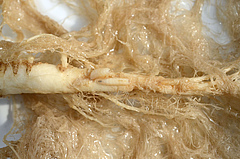24.04.2017 | MIE Group News
New research article in Journal of Ecology

Delia radicum larvae attacking the taproot of Brassica rapa. The taproot is the most defended organ in the root system
Note for the media: Use of the pictures provided by iDiv is permitted for reports related to this media release only, and under the condition that credit is given to the picture originator.
Optimal defence theory (ODT) is one of the most prominent theoretical frameworks to explain the allocation of defence compounds within plants. The ODT has been well worked out and experimentally tested for shoot defences, but not for root defences. This paper reported that ODT generally applies to glucosinolate allocation in aboveground and belowground organs and may mainly serve to maintain the integrity of the main plant structure. Moreover, it suggests that aboveground and belowground insect herbivores independently exert similar selection pressures on defence allocation patterns in root and shoots.
